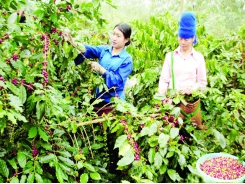New trends in Vietnams rice exports

Vietnam exported 5.15 million tonnes of rice, worth US$2.6 billion, in the first ten months of 2018. (Photo: Internet)
2018 is witnessing new trends in Vietnam’s rice export sector, notably the priority of exporting high-quality rice through international bidding as well as stricter and more diverse trade barriers from importing countries.
Preliminary data by the General Department of Customs shows that Vietnam exported 264,500 tonnes of rice in October, generating a revenue of US$135.56 million, up 22.96% in volume and 31.8% in value, compared with the same month last year.
The total volume of rice exports in the first ten months of 2018 was 5.15 million tonnes, worth US$2.6 billion, representing year-on-year increases of 6.62% and 21.49% in volume and revenue respectively.
What is notable during the period is that the price of Vietnamese rice has now surpassed that of Thailand, averaging at more than US$500 a tonne, up about 15%.
In 2016, Vietnam exported 4.8 million tonnes of rice, bringing in US$2.1 billion. The respective volume and revenue figures rose to 5.8 million and US$2.6 billion the following year. And in 2018 Vietnam has set a target to ship 6.5 million tonnes.
Such positive results come due to not only growing global demand and higher prices but also Vietnam’s marked shift towards producing and exporting high-quality and specialty rice varieties.
The global rice market has recently seen a trend towards prioritising international bidding processes and attaching greater importance to quality. At the same time, more and more non-tariff barriers are emerging. For example, China, a major importer of Vietnamese rice, has also imposed strict requirements through quotas and food safety checks.
The greatest challenge to Vietnamese rice exporters is now the laws of importing countries, with numerous stringent requirements on quality, food safety and origin.
In the meantime, most of Vietnamese rice exporters are small- and medium-sized businesses with little experience in dealing with trade lawsuits and international technical barriers.
Therefore, Vietnamese enterprises should actively learn and update themselves about new information in order to promptly adjust their business plans and remedy their shortcomings.
Furthermore, enterprises also need to work together to build supply chains for exports to add more value to Vietnamese commodities as well as cooperating with local businesses so as to meet the technical barriers.
Related news
Tools

Phối trộn thức ăn chăn nuôi

Pha dung dịch thủy canh

Định mức cho tôm ăn

Phối trộn phân bón NPK

Xác định tỷ lệ tôm sống

Chuyển đổi đơn vị phân bón

Xác định công suất sục khí

Chuyển đổi đơn vị tôm

Tính diện tích nhà kính

Tính thể tích ao



 Hiep Hoa district boosts experience exchange with Gifu…
Hiep Hoa district boosts experience exchange with Gifu…  Awakening the world to Son La coffee brands
Awakening the world to Son La coffee brands